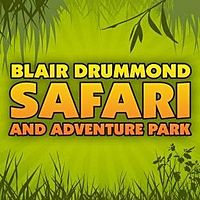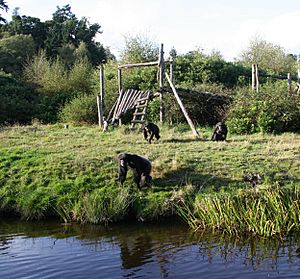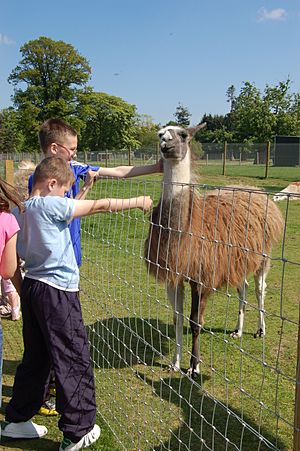Blair Drummond Safari Park facts for kids
 |
|
| Date opened | 15 May 1970 |
|---|---|
| Location | Blair Drummond, Stirling, Scotland |
| Land area | 120 acres (49 ha) |
| Coordinates | 56°09′54″N 4°02′17″W / 56.165°N 4.038°W |
| No. of animals | 350 |
| Memberships | BIAZA, EAZA |
Blair Drummond Safari Park is a super fun place to visit near Stirling in Scotland. It's a special park where you can see over 350 animals! Many of these animals roam freely in huge areas, just like they would in the wild. The park covers about 120 acres (that's like 90 football fields!). It first opened its doors on May 15, 1970. You can visit from mid-March until the end of October each year. It's one of Scotland's most popular places for tourists!
Contents
Park History: How it Started
The land where Blair Drummond Safari Park is today has a long history. The original Blair Drummond House was built way back in 1715. Later, in 1916, a man named Sir John Kay bought the house and its land. He passed it down to his nephew, Sir John Muir. The park's current owner, Jamie Muir, is his grandson!
Blair Drummond Safari Park officially opened in 1970. It was one of the first safari parks in Britain, following Longleat Safari Park which opened a few years earlier.
Explore the Animal Reserves
At Blair Drummond, you can drive your own car or ride the park's special "Safari Bus" through large reserves. This lets you get super close to animals that roam freely. Imagine seeing lions, zebras, rhinos, camels, and monkeys right outside your window!
African Animal Reserve
The first reserve is home to amazing animals from Africa. Here, you'll see plant-eating animals like Grant's zebra, Ankole-Watusi cattle, and Southern white rhinoceros. The rhinos are part of a special breeding program across Europe. This program helps to make sure these animals have healthy babies and their species continues to thrive. Some of the rhinos you see, like Dorothy and Graham, have had five calves right here at the park!
Lion Reserve: Meet the Kings of the Jungle
The second reserve is just for African lions! They are also part of a European breeding program. This helps keep their family lines strong and diverse. You might see Zulu, the male lion, who joined the park in 2016. Two of the female lions were even born at Blair Drummond!
Monkey Jungle: Barbary Macaques
The third reserve, called "Monkey Jungle," opened in 2015. It's home to many Barbary macaques. These monkeys came from Gibraltar in 2014. They were moved to the park to help solve problems they were causing for people there. The Barbary macaque is an endangered animal. The park helps raise money to protect these monkeys in the wild, especially those used as photo props in Morocco.
Asian Animal Reserve
The fourth and final reserve features plant-eating animals from Asia. Here, you can spot unique animals like Père David's deer, Bactrian camels, and Eld's deer. In April 2016, two Père David's deer calves were born at the park. This is very special because this type of deer is now extinct in the wild!
Attractions in the Park
Besides the driving reserves, there are many other exciting areas to explore on foot!
Lemur Land: Walk Among Lemurs
To get to Lemur Land, you cross a bridge. This is a fantastic place where you can walk right through the home of ring-tailed lemurs, brown lemurs, and other lemur types. The lemurs roam freely around you! They love to play on tall trees and thick ropes. There are even feeding tables where you can get super close to them.
In Lemur Land, you can also see Red river hogs, Somali sheep, and two large African spurred tortoises.
Chimp Island: A Boat Safari Adventure
Next to Lemur Land, you can take a fun Boat Safari to "Chimp Island." This island is home to a family of chimpanzees! An experienced guide will take you around the island by boat. You can watch the chimps search for food hidden in special toys and plants. This helps keep them active and happy.
Meet Mondula the Elephant
The safari park is home to a female african elephant named Mondula. She spends her day exploring her large enclosure. Her keepers provide her with lots of fun things to do. On most days, you can watch the keepers train Mondula. She gets yummy food as a reward for showing good behaviors. You might even see her present her feet, mouth, ears, and tail for inspection and cleaning! Her amazing enclosure opened in 2013.
Birds of Prey Shows
Several times a day, you can watch incredible bird of prey displays. The park's expert bird trainers show off the amazing abilities of birds like Harris' hawks, eagle owls, and falcons. The birds fly very close to the visitors, and the trainers explain all about them. It's a great chance to see these powerful birds up close!
Pets' Farm: Cuddly and Exotic Animals
The Pets' Farm area has many friendly farm animals. You can meet pygmy goats, Shetland ponies, llamas, and kunekune pigs. But it's not just farm animals! You'll also find more exotic creatures like slender-tailed meerkats, Humboldt penguins, and Oriental small-clawed otters.
Viewing Platforms
All around the park, there are special viewing platforms. These platforms are great for everyone, including those in wheelchairs. They let you look down into some of the animal enclosures from a higher spot. You can find them at the giraffe and ostrich enclosure, the lion reserve, and the Amur tiger habitat.
More Fun Activities
Blair Drummond Safari Park has lots of other exciting things to do!
Rides and Play Areas
The park has a huge slide and a fantastic playground. You'll find a pirate ship and an adventure fort, all in a big sand pit. Part of the sand pit is covered, so you can play even if it rains! Near the sea lion building, there's another large slide. Close to the boat safari, you can try pedal boats and a flying fox. Other fun rides include dodgems, a kids' dragon rollercoaster, a bouncy castle, and a carousel.
Eating at the Park
When you get hungry, there's a restaurant and several snack places. If you bring your own food, there are picnic tables available. You can even bring your own BBQ food! The safari park will supply and light a Barbecue for you at no extra charge.
Learning About Animals
The park is a great place to learn!
Animal Talks
Throughout the day, the education team gives talks at six different animal enclosures. You can learn about the elephants, giraffes, tigers, rhinos, penguins, and meerkats. These talks teach you about where the animals live in the wild, how they behave, and interesting facts about them. Some talks even include feeding times, so you can see the animals in action!
Volunteer Programs
The zoo also has volunteer programs for people who want to help. Animal volunteers, often college students, help zookeepers with daily tasks. This includes cleaning enclosures, preparing food, and setting up fun activities for the animals. Education volunteers help visitors learn, work at touch tables, and help with school talks and fundraising events.
Successful Breeding Programs
Blair Drummond Safari Park is a member of the British and Irish Association of Zoos and Aquariums (BIAZA). This means they work with other zoos in the UK and Ireland on special breeding programs. These programs help protect endangered animals.
Animals that have had babies at the park include:
- Lions
- Giraffes
- Grant's zebra
- Pere David's deer
- Bactrian camels
- Southern white rhinos
- Marmosets
- Llamas
- Lechwe
- Chimpanzees
- Fallow deer
- Ostriches
In 2010, something amazing happened! A woman in Cyprus was watching the rhino enclosure on the park's webcam. She saw one of the rhinos giving birth and alerted the staff!
Helping Conservation Efforts
Blair Drummond Safari Park cares a lot about protecting animals in the wild. They have an initiative called ‘Link to the Wild’. This program raises awareness and money for conservation projects. The donations come from visitors like you!
Images for kids
See also
 In Spanish: Parque safari de Blair Drummond para niños
In Spanish: Parque safari de Blair Drummond para niños






